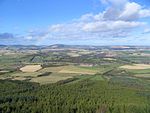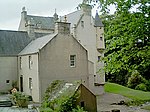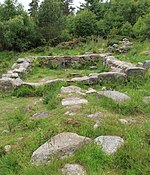Bennachie

Bennachie ( ben-ə-HEE; Scottish Gaelic: Beinn na Cìche) is a range of hills in Aberdeenshire, Scotland. It has several tops, the highest of which, Oxen Craig, has a height of 528 metres (1,732 ft). Though not particularly high, compared to other peaks within Scotland, the mountain is very prominent, owing to its isolation and the relative flatness of the surrounding terrain, and dominates the skyline from several viewpoints. The peak that stands out the most visually is Mither Tap (518 m, 1699 feet) and from its top there are good views of the county to the north and east. Most of the tops lie along an east / west ridge, with the exception of Millstone Hill (409 m) an outlier or spur which is separated from and to the south of the main ridge. Mither Tap has an Iron Age fort on its summit. Unlike with many other hilltop forts in the area, there are no signs of vitrification in the stone. Bennachie is visible from a number of distant points; to the north it is visible from Longman Hill, a point considerably to the north.
Excerpt from the Wikipedia article Bennachie (License: CC BY-SA 3.0, Authors, Images).Bennachie
Ruelle du Chanoine Tarde, Sarlat-la-Canéda
Geographical coordinates (GPS) Address Nearby Places Show on map
Geographical coordinates (GPS)
| Latitude | Longitude |
|---|---|
| N 57.29275 ° | E -2.56244 ° |
Address
Château de Tarde
Ruelle du Chanoine Tarde
24250 Sarlat-la-Canéda
Nouvelle-Aquitaine, France
Open on Google Maps







